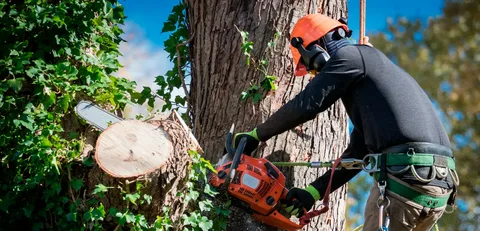Do Tree Care Services Help with Invasive Bug Infestations?

Interestingly, invasive bugs cause billions of dollars in tree damage every year in the U.S. Indeed, from beetles to moths, these pests can consume entire tree populations. Consequently, their impact on ecosystems can be significant. Homeowners frequently observe dying trees; however, they may not realize that bugs are the underlying cause. Here is where professional tree care becomes essential. When done right, these services don’t just make trees look better—they help protect them, too.
So, Douglas tree care services know how to deal with these pests. Their job goes beyond trimming branches. They inspect trees, treat infestations, and help prevent future ones. Let’s break down how tree care services help when bugs attack your yard.
What Are Invasive Bugs and Why Should You Get Douglas Tree Care Services
Invasive bugs aren’t just annoying—they’re dangerous to trees. These bugs aren’t native to the U.S. and spread quickly without natural predators. Once they take over, they destroy leaves, bark, and even roots.
You may have heard of these common offenders:
- Emerald Ash Borer
- Spotted Lanternfly
- Asian Longhorned Beetle
- Gypsy Moth
These pests are sneaky. Most people don’t spot them until the tree is already sick. Therefore, it is wise to schedule regular checkups with professionals such as tree care services. They can catch the signs early, which is crucial for timely intervention. Moreover, early treatment significantly impacts outcomes.
How Tree Care Services Identifies Bug Problems
Spotting an infestation isn’t always easy. That’s where trained eyes help. Tree care crews know what to look for and how bugs behave. Here’s what they usually check:
- Holes in the bark or trunk
- Discolored or thinning leaves
- Sawdust-like material near the base
- Sticky sap or tree wounds
- Insect sightings or egg masses
During an inspection, techs may use special tools to check under bark or inside soil. Some even use pheromone traps to attract and track certain bugs. Once they know the bug, they can decide on a safe treatment plan.
Treatment Options Tree Pros Can Offer
Not every infestation needs chemicals. In fact, most pros try safer steps first. Here’s how they fight back:
- Tree trimming to remove infected branches
- Soil treatments with nutrients or natural bug control
- Bark sprays that protect without harming bees or pets
- Tree injections that target pests deep inside
Also, tree care teams often use beneficial bugs to control the bad ones. These good bugs keep the population balanced. For example, ladybugs eat aphids that chew leaves.
Alongside those efforts, Douglas tree care services keep watch after treatment. Follow-up care helps ensure the bugs don’t come back. This ongoing care is key.
Why Tree Trimming and Pruning Matter
Regular pruning might seem like a beauty job, but it’s also a health step. Removing weak or dead limbs does more than clean up your tree; it also prevents bugs from moving in.
Trimming helps by:
- Taking out deadwood that attracts bugs
- Letting sunlight and air reach the center
- Helping trees grow strong and less vulnerable
- Removing parts already infected with bugs
But don’t go DIY on this. Improper cuts can stress trees and invite more bugs. Hiring experts like the tree care services team ensures it’s done right.
How Bug-Prevention Plans Save Trees
Moreover, you can take action without waiting for signs of damage. Many companies, therefore, now offer year-round tree care packages that include bug checks. These prevention plans consist of the following:
- Regular inspections and reports
- Early detection of pest activity
- Seasonal treatments to block bug cycles
- Nutrient boosts to make trees stronger
- Advice on watering and mulching
Getting Douglas tree care services means fewer surprise problems. Your trees stay healthier, and you avoid big repair costs later.
Do Invasive Bugs Spread from Tree to Tree?
Yes, many bugs jump from one tree to another. Additionally, some even fly miles to reach new homes. When your neighbor has a bug problem, your trees could likely be next. Consequently, it is important to stay vigilant. For that reason, taking swift action is crucial.
The bugs can return if you treat one tree but ignore the others. Full-yard treatment is the best way to stop the spread. Plus, First Responder Tree and Lawn Services LLC can spot bugs that you haven’t even seen yet.
By treating the whole area, they break the bug’s life cycle. This approach works better than spot-treating and helps keep your entire yard safe.
Other Lawn and Garden Tips to Fight Invasive Pests
While tree care services are essential, a healthy lawn also plays a role. Bugs love weak trees and messy yards, so keeping things clean makes your yard less inviting to pests.
Here’s what you can do:
- Rake leaves and remove debris regularly
- Avoid over-watering, which attracts pests
- Use mulch wisely—don’t pile it against trunks
- Keep grass trimmed and remove weeds
- Store firewood away from your house or trees
Even small steps can have a big impact. However, don’t skip professional support. With your efforts, crews like care services add the expert touch that matters most.
Are Tree Care Services Worth the Cost?
Some folks worry about the price of tree care. But let’s be real—removing a dead tree can cost thousands. Treating early is much cheaper. Plus, healthy trees add value to your property.
When bugs strike, fast action saves both trees and money. So, First Responder Tree and Lawn Services LLC offers options to fit different budgets. They also give clear advice and don’t push unnecessary treatments.
Think of tree care as insurance. You wouldn’t skip oil changes for your car. The same goes for trees. A little care now avoids big problems later.



